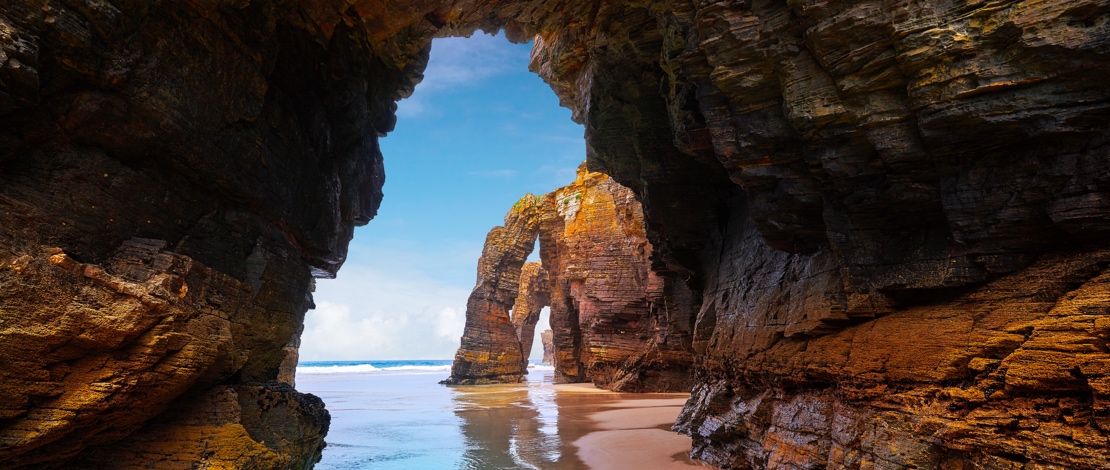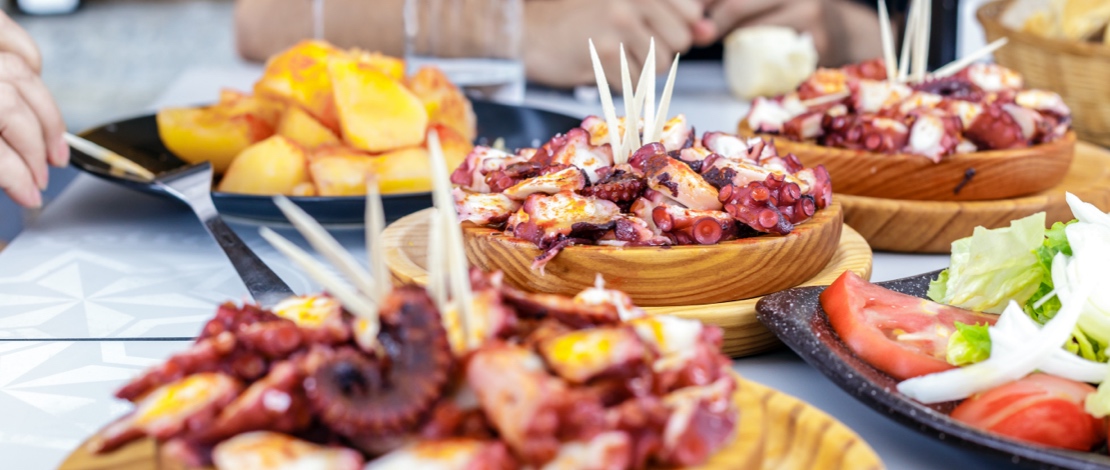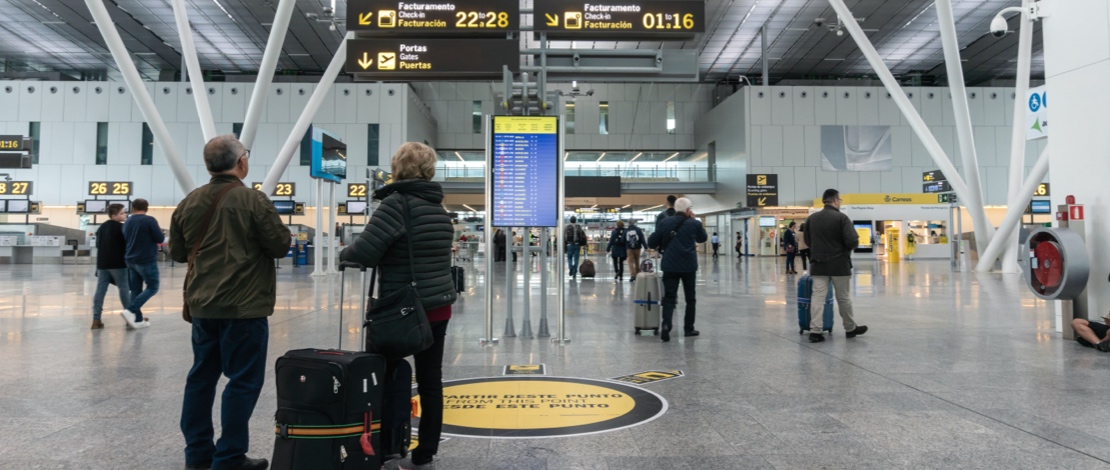
Galicia
Perched on the north-western tip of Spain
Perched on the north-western tip of Spain and surrounded by both the Atlantic Ocean and the Cantabrian Sea, this area is famous for its landscapes of vast forests, green wooded valleys, wild beaches and lighthouses. Visit its capital and the different cities, as well as the National Maritime-Terrestrial Park of the Atlantic Islands of Galicia.
-
MUST-SEE
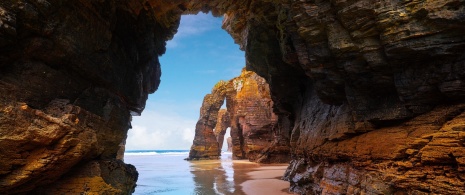
Santiago de Compostela
The capital of Galicia is famous for being the final destination of the Camino de Santiago, an important pilgrimage route that ends at the city's Cathedral, which is an impressive example of Romanesque and Gothic architecture. Stroll through its beautiful old town, declared a UNESCO World Heritage Site. Visit the Alameda Park, Obradoiro Square and the Museum of the Galician People. And don't forget to visit the City of Culture of Galicia, one of the most stunning places in the capital. Its incredible design recreates a new peak on Mount Pedroso and you'll be blown away by how unique these buildings are. If you can, go up to this area at dusk for spectacular views of the sunset over the city.
Other cities
A Coruña, Vigo, Pontevedra, Ferrol, Lugo and Ourense offer historic charm, stunning architecture and a vibrant cultural life. Explore their streets, visit their museums and enjoy the bustling atmosphere of Galician life. For example, in Lugo you can admire its Roman Wall, which surrounds the entire city centre and is the only one in the world that has been preserved in its entirety. It is a World Heritage Site.
Rías Altas
These are the estuaries of northern Galicia that overlook the Atlantic. Incredible cliffs, beaches, fishing villages, lighthouses and legends are the key "ingredients" of this coast. Don't miss the Tower of Hercules in A Coruña, one of the oldest working Roman lighthouses in the world. You will also love the monuments of Betanzos, the Pazo de Mariñán or the Sanctuary of San Andrés de Teixido. According to tradition, all Galicians have to go on pilgrimage at least once in their lives to this sanctuary in order to have a full life and not just be a "soul in pain".
Playa de Las Catedrales
If you go to this beach, you will see that it is surrounded by cliffs, crevices, caves and large arches, which you can cross underneath when the tide goes out. You can also take a leisurely stroll around Ribadeo before lunch.
Costa da Morte
From Malpica to Finisterre: attractive natural beauty and the powerful oceans currents will captivate you on this route. Also, its winding roads and long beaches run into green meadows and cliffs. You can go as far as Cape Finisterre, considered the end of the world in Roman times.
Rías Baixas
This is the coastline where the Cíes Islands are located. The coast goes from the estuaries of Muros and Noia to the mouth of the Miño, in A Guarda (Pontevedra). You will find heavenly beaches with deep blue water and white sand. We also recommend beaches such as A Lanzada, in O Grove, and the Illa de Arousa, with 36 kilometres of coastline and made up of solitary beaches that you will adore.
Maritime-Terrestrial National Park of the Atlantic Islands of Galicia
This is made up of the archipelagos of Cíes, Ons and Cortegada (in Pontevedra) and Sálvora (in A Coruña). This is where freshwater and saltwater converge to create a unique ecosystem, full of marine and terrestrial life. Long beaches of fine sand and an almost transparent blue will be the magnet that draws you to this paradise on earth.
Ribeira Sacra
An area that includes the banks of the rivers Cabe, Sil and Miño. It has been named a Biosphere Reserve together with the Serras do Oribio and Courel and here you will find a dozen interesting medieval monasteries in the middle of nature and some magnificent natural viewpoints.
-
GASTRONOMY
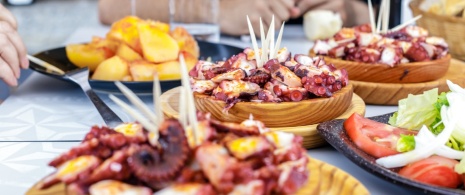
Galician seafood is well known for its quality. You can't visit without trying its prawns, scallops, mussels, crabs and lobsters, which have served as inspiration for dishes such as "pulpo á feira" (octopus cooked with potatoes and seasoned with paprika). Nor can you leave without having a mariscada (a dish that includes different types of seafood). You can also try Galician empanadas (pies) and padrón peppers.
The Tourist Board's website offers the best culinary options for tasting the food of Galicia.
-
HOW TO GET THERE?
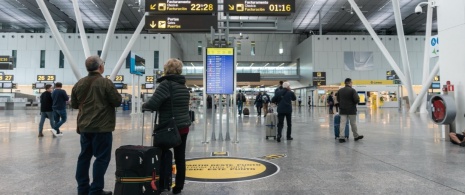
You have several transport options to get to Galicia. You can fly to Santiago de Compostela Airport, A Coruña Airport or Vigo Airport from different cities. You can also arrive by boat, as the Autonomous Community has more than 1,300 ports. Another option is to take Renfe high-speed trains from Madrid or other Spanish cities, or travel by bus from different parts of Spain to cities such as Santiago de Compostela or Vigo. Alternatively, you can drive, and there are motorways and roads connecting Galicia with Madrid, Bilbao and other cities. The A-8 connects with cities in northern Spain and the A-6 and A-52 from Madrid. Once in Galicia, you can travel between cities and places of interest using public transport or rent a car to explore the region at your own pace.
